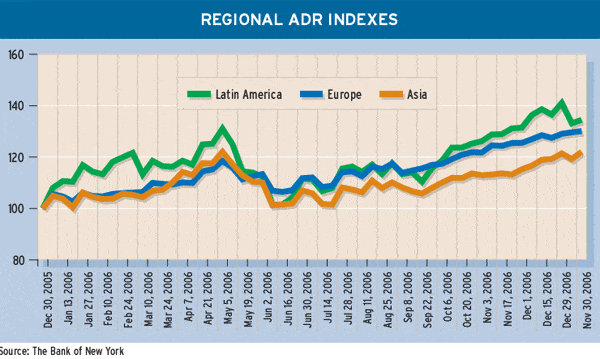Global Equity/Drs
Initial public offerings in the form of depositary receipts rose more than 75% in 2006 from a year earlier to a record $20.9 billion, according to a year-end analysis by Citigroup. The previous record of $17.1 billion was set in 1994 and was nearly matched by the $16.9 billion total in 2000.
A receptive investor market, a rally from the mid-year global market downturn, and liquid trading conditions were major drivers of the surge in DR IPOs overall, says Nancy Lissemore, managing director of depositary receipt services for Citigroup Corporate and Investment Banking.
The recent trend toward London and Luxembourg listings is continuing, Lissemore says. Nearly 81% of last years total raised through primary offerings was in the form of global depositary receipts, or GDRs, listed in these European financial centers, as against only 19% listed on US exchanges. The balance has shifted from 2000, when 89% of DR IPOs from non-US companies were listed on US exchanges, she says.
GDRs are DRs issued simultaneously in two or more markets through a global offering.
Russian oil company Rosnefts $6.4 billion IPO in GDR form in July 2006 was the largest DR capital raising in history. The issue was listed on exchanges in Moscow and London.
The total year-to-date 2006 capital raised in DR form, including primary and secondary offerings as of December 12, was $28.2 billion, a 3% decrease from the full-year 2005, according to Citigroups report. A record $30 billion of IPO and follow-on offerings combined was raised in 2000.
The US Securities and Exchange Commission took several actions of potential significance to non-US issuers at its open meeting on December 13, according to Citigroup. These actions included interpretative guidance regarding the implementation of Section 404 of the Sarbanes-Oxley Act and a revised rule proposal relating to foreign issuer deregistration.
The SEC voted to propose for public comment measures to improve implementation of Section 404, with the comment period open until February 26, 2007. The agency proposed amendments to rules to provide that the SECs guidance is a safe harbor for managements compliance with the annual evaluation of internal controls over financial reporting. Other proposed amendments would clarify the auditors reporting requirement under Section 404.
The SEC also voted to re-propose amendments governing when a foreign private issuer, meaning a company incorporated outside the United States, may terminate registration of classes of securities under the Securities Exchange Act and exit the SEC reporting system. Under the new exit rules, a companys ability to deregister would be determined primarily on the basis of the trading volume of its securities in the United States, according to an analysis by the law firm of Thacher Proffitt & Wood.
The re-proposed rules are simpler and, it appears, easier to satisfy than the SECs original proposal, issued in December 2005, the law firm says. The original proposal used both the percentage of US shareholders and US trading volume as thresholds for determining a companys ability to deregister.
The current SEC rules governing deregistration are outdated and rarely accommodate the needs of non-US companies in the modern era where cross-border securities offerings and cross-border investments are widespread, according to the law firm.
It is likely that many non-US companies will avail themselves of the new rules, if adopted, to deregister and exit the US public securities markets, Thacher Proffitt & Wood says. At the same time, however, the existence of a newer, more streamlined and more lenient set of deregistration rules may encourage non-US companies to have less concern about entering the US markets and the SEC reporting system in the first place, it says.

Gordon Platt



